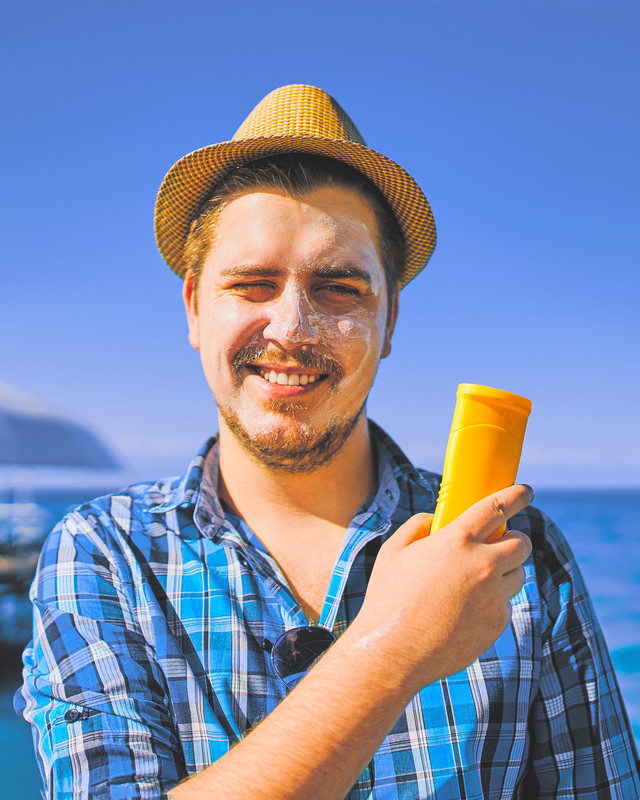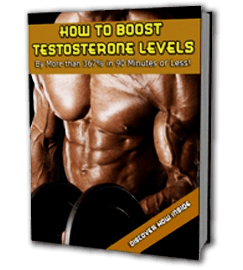(Article Medically Reviewed By Dr. Zach Hyde)
Does sunscreen lower testosterone?
I’ve never been shy about proclaiming the danger inherent in the chemicals we’re exposed to every day.
However, if you take heed of one warning, I hope that it will be about the extensive hormonal damage that can result from the use of sunscreen.
As we progress through this article, I hope to demonstrate that this chemical-laden cocktail isn’t just bad for you, but it’s one of the worst chemical mixtures you could ever expose yourself to.
Sunscreen is an “Endocrine Disruptor”
If you think back to health class, you might remember that our skin is actually our largest organ.
While we may only think of it merely as an “outer shell” holding in all of our inside parts, it is as susceptible to damage as our hearts, lungs, stomach, or testicles.
And since people who lack melanin burn easily in the sun, sunscreen has been proposed as a logical way to keep our skin healthy.
And while you might expect that anything with the power to stop the sun would require some chemicals, you might assume it’s not that big of a deal because we’re only putting them on the outermost layer of the dermis.
However, our skin is surprisingly permeable. So, whatever we put on it, we also put in it.
Unfortunately, in the case of sunscreen, what we’re putting on our skin is multiple endocrine-disrupting compounds.
Specifically, we’re talking about the following:
- Benzophenones
- 4-Methylbenzylidene camphor
- Parabens
- Octyl-dimethyl-PABA
- Octyl-methoxycinnamate
- Homosolate
The Cocktail of Chemicals in Sunscreen
Don’t worry, because this site is not about simply dropping a bunch of scary-sounding chemical names and letting you assume that they’re bad for you.
(even though this is often the case).
In the interest of truly hammering home why you need to avoid sunscreens like the plague, we’re going to take a look at the scientific studies behind the aforementioned toxic ingredients.
Benzophenones (Lowers Testosterone)
One investigation into male reproductive disorders found that benzophenone-1 (BP-1) exposure significantly decreased testosterone levels and androgen receptor activity in vitro.
BP-2, on the other hand, was found to reduce testosterone and Leydig Cell function in both developing humans and rats.
The study also showed evidence of thyroid hormone disruption, which has the potential to have long-term metabolism ramifications.
A much more damning study published in the Journal of Complementary Medicine found…
That three active ingredients in most sunscreens (benzephone-3, 4-MBC, and octyl-methoxycinnamate) could decrease testosterone and estradiol levels after just one week of topical application.
This backs up information found in other studies, which have helped label benzophenones “anti-androgenic,” which means they can keep DHT from binding to androgen receptors altogether.
But the scariest thing about benzophenones is that they are highly effective at penetrating the skin and entering the bloodstream.
In fact, studies have been done that show benzophenones in the urine samples of almost all subjects who used these products topically.
In one example, 96.8% of some 2,517 subjects tested positive.
4-Methylbenzylidene Camphor (xenoestrogen)
The UV-B filter 4-Methylbenzylidene Camphor (4-MBC) isn’t just an unpronounceable amalgam of consonants – it’s also a potent xenoestrogen.
This means that it can mimic the effects of natural estrogen in the body and activate those receptors en masse.
These effects have been shown to take place in both in-vitro and in-vivo studies.
One study, in particular, highlighted the effectiveness of the way 4-MBC penetrated the dermis.
Other research indicates that 4-MBC can directly impact the function of both the pituitary and thyroid glands.
In one rodent study, for instance, the effects were similar to hypothyroidism and significantly lowered T3 and T4 levels in the subjects.
All of this research seems to indicate that 4-MBC is basically kryptonite for your testosterone production.
Parabens (Endocrine Disruptor)
Parabens have received so much bad press over the past few years that most companies are racing to advertise that their products are “paraben-free.”
They are typically found in cosmetics, skin lotions, shampoos, and soaps. Of course, as you’d expect, they are almost universally found in sunscreens.
Among the plethora of negative responses, parabens can stimulate is an increase in estrogen response, which one study found is heightened by the fact that so many types of parabens are present in sunscreen.
Many doctors suspect that repeated exposure may have long-term effects for the endocrine system leading to reduced testosterone production.
Octyl-dimethyl-PABA (Increases Estrogen Activity)
Octyl-dimethyl-PABA (padimate-O) is a UV-B blocker.
Despite its particularly sinister-sounding name, it actually might be one of the least troublesome ingredients in your local sunscreen aisle.
Even so, some studies have shown this chemical to be a somewhat low-grade endocrine system disruptor that can contribute to higher estrogen activity over time.
Unfortunately, not much else is known about it right now, mostly due to the fact that there are so many “bigger fish to fry” in the average sunscreen cocktail.
Octyl-Methoxycinnamate (Toxin)
Octyl-methoxycinnamate first came under the gun (and rightfully so) back in 2000.
That’s when a study was published that showed the chemical to be highly toxic to rats – specifically in doses identical to what you’d get from applying sunscreen.
And while it may not be as easily absorbed into the bloodstream as other chemicals on this list, it can still contribute to cell damage and increased estrogenic activity.
It’s also important to mention that octyl-methoxycinnamate was one of the ingredients used in the benzophenone study listed above.
Homosolate (Anti-Androgenic)
Homosolate is yet another chemical that has demonstrated an ability to disrupt the endocrine system in both humans and rodents.
Its crimes include being identified as an anti-androgen and contributing to increased activity in estrogen receptors.
However, due to its fast ability to permeate the skin, one of the primary concerns is that Homosolate will break down into more toxic byproducts once it enters the bloodstream.
Does Sunscreen Lower Testosterone – Conclusion:
Without getting all “tin foil” hat on you, I think it’s important to remember that our ancestors (regardless of melanin content) have spent thousands of years out in the sun.
Have sunburns and skin cancer always been a thing? Sure. However, skin cancer rates have actually increased since the invention of sunscreen.
The point is: sunscreen is a product put out by businesses.
As with any other product, those businesses have a vested interest in selling as many tubes as they can, with little concern for what happens once the sticker is removed.
And with study after study showing that the chemical cocktail present in these lotions can drastically influence our hormones, an umbrella and a t-shirt seem like far better options for your next trip to the beach.



